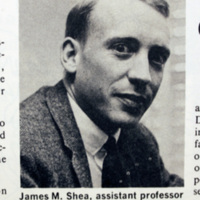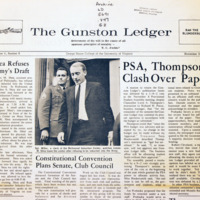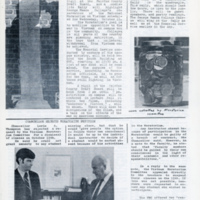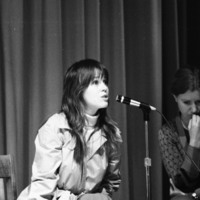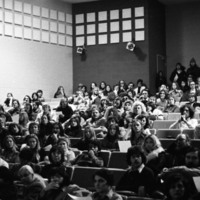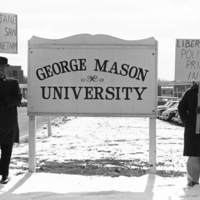The Cold War as A Source of Dissent at George Mason College/University
George Mason College of the University of Virginia (it became an independent university in 1972) was a very small institution of less than 1,800 students, faculty, and staff in the 1960s. Its student body at that time came mostly from local bedroom communities such as Alexandria, Fairfax, Falls Church, and Springfield. They were mostly from middle to upper-middle class white families. Most would say that their politics were conservative and would not characterize themselves as activists. Yet, as the US presence in South-East Asia grew during the Vietnam War [from a small number of military advisers in the 1950s to a high point of over 500,000 soldiers in 1968], some Mason students and their professors began actively protesting our country’s attempts to stop the spread of communism through war.
One such professor was Dr. James Shea in the Philosophy Department. Shea joined Mason in 1966. A pacifist, he took issue with drafting young men into military service, particularly to fight in Vietnam. Beginning In 1967 Shea initiated or took part in several acts of political disobedience pertaining to the United States’ war effort in Vietnam. He returned his draft card, unsigned, to the local draft board, and led teach-ins against the war and draft card burnings at the Fairfax Post Office. Most notably he walked out of a Richmond induction center during his induction into the service, and refused to pay taxes, claiming the orphan children of Vietnam as dependents. After being convicted of tax evasion in 1970, Shea abruptly left Mason and the area in the middle of the fall term to avoid serving a prison term. He returned to the area three years later to serve his sentence.
The administration at Mason was under pressure, both externally and internally, to terminate Dr. Shea during this period, but did not act until the fall of 1970. While most students at Mason did not agree with Dr. Shea’s approach to protest, those who attended his classes generally thought he was a good professor who encouraged them to think deeply about issues. Shea had support from the student newspaper, Broadside, which beginning in 1967, changed its editorial slant against American involvement in Vietnam. Broadside served as the main source of news for the campus about the Shea case.
Students, faculty, and staff took an active interest in questioning American involvement in Southeast Asia through demonstrations and other events. Over 600 members of the Mason community (nearly one-third of the campus) signed a petition asking Mason’s Chancellor Lorin A. Thompson to excuse students, faculty, staff and administration from classes and college business on October 15, 1969 so that they might have the opportunity to take part in local events pertaining to the Vietnam War Moratorium. The Moratorium was a day-long series of events held in municipalities and on college campuses across the United States and the world to call attention to and protest the War. In May of 1970 a group of students circled the flagpole in front of the North Building (now Finley) demanding the flag be lowered in honor of the students killed at Kent State while protesting the U.S. invasion of Cambodia during the Vietnam War. To avoid a “small riot” in his own words, Thompson allowed the flag to be lowered for 30 minutes satisfying members in the group. In February 1974 Jane Fonda, husband Tom Hayden, and folk singer Holly Near visited George Mason University to facilitate a teach-in on US involvement in Southeast Asia held in the Lecture Hall. Inside the building, about 100 students, faculty and staff participated in the discussion, while outside a couple from Fairfax picketed the event.

